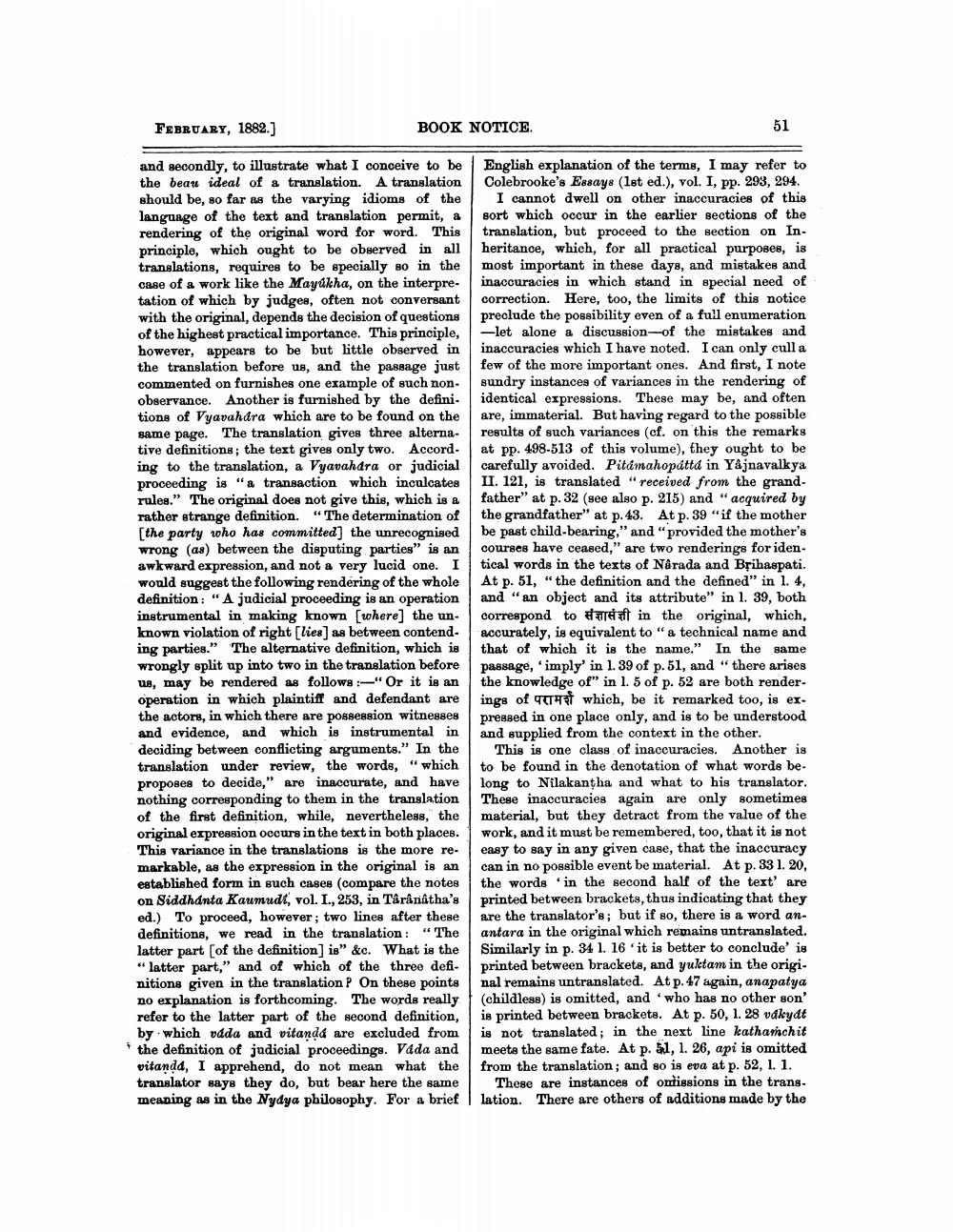________________
FEBRUARY, 1882.]
BOOK NOTICE.
51
and secondly, to illustrate what I conceive to be the beau ideal of a translation. A translation should be, so far as the varying idioms of the language of the text and translation permit, & rendering of the original word for word. This principle, which ought to be observed in all translations, requires to be specially so in the case of a work like the Mayúkha, on the interpretation of which by judges, often not conversant with the original, depends the decision of questions of the highest practical importance. This principle, however, appears to be but little observed in the translation before us, and the passage just commented on furnishes one example of such nonobservance. Another is furnished by the defini. tions of Vyavahdra which are to be found on the same page. The translation gives three alternative definitions; the text gives only two. Accord. ing to the translation, a Vyavahara or judicial proceeding is "a transaction which inculcates rules." The original does not give this, which is a rather strange definition. "The determination of (the party who has committed] the unrecognised wrong (as) between the disputing parties" is an awkward expression, and not a very lucid one. I would suggest the following rendering of the whole definition: "A judicial proceeding is an operation instrumental in making known (where] the un. known violation of right [lies] as between contend. ing parties." The alternative definition, which is wrongly split up into two in the translation before ue, may be rendered as follows:-"Or it is an operation in which plaintiff and defendant are the actors, in which there are possession witnesses and evidence, and which is instrumental in deciding between conflicting arguments." In the translation under review, the words," which proposes to decide," are inaccurate, and have nothing corresponding to them in the translation of the first definition, while, nevertheless, the original expression occurs in the text in both places. This variance in the translations is the more remarkable, as the expression in the original is an established form in such cases (compare the notes on Siddhanta Kaumudi, vol. I., 253, in Târânatha's ed.) To proceed, however; two lines after these definitions, we read in the translation : "The latter part [of the definition) is" &c. What is the " latter part," and of which of the three defi. nitions given in the translation on these points no explanation is forthcoming. The words really refer to the latter part of the second definition, by which udda and vitanda are excluded from the definition of judicial proceedings. Vada and vitandd, I apprehend, do not mean what the translator says they do, but bear here the same meaning as in the Nydya philosophy. For a brief
English explanation of the terms, I may refer to
Colebrooke's Essays (1st ed.), vol. I, pp. 293, 294. 1 I cannot dwell on other inaccuracies of this
sort which occur in the earlier sections of the translation, but proceed to the section on Inheritance, which, for all practical purposes, is most important in these days, and mistakes and inaccuracies in which stand in special need of correction. Here, too, the limits of this notice preclude the possibility even of a full enumeration - let alone a discussion-of the mistakes and inaccuracies which I have noted. I can only culla few of the more important ones. And first, I note sundry instances of variances in the rendering of identical expressions. These may be, and often are, immaterial. But having regard to the possible results of such variances (cf. on this the remarks at pp. 498-513 of this volume), they ought to be carefully avoided. Pitamahopátta in YAjnavalkya II. 121, is translated "received from the grandfather" at p. 32 (see also p. 215) and "acquired by the grandfather" at p. 43. At p. 39"if the mother be past child-bearing," and "provided the mother's courses have ceased," are two renderings for iden. tical words in the texts of Narada and Brihaspati. At p. 51, "the definition and the defined" in l. 4, and "an object and its attribute" in l. 39, both correspond to e ft in the original, which, accurately, is equivalent to " a technical name and that of which it is the name." In the same passage, 'imply' in 1. 39 of p.51, and "there arises the knowledge of" in 1. 5 of p. 52 are both renderings of the which, be it remarked too, is ex. pressed in one place only, and is to be understood and supplied from the context in the other.
This is one class of inaccuracies. Another is to be found in the denotation of what words be. long to Nilakantha and what to his translator.
These inaccuracies again are only sometimes material, but they detract from the value of the work, and it must be remembered, too, that it is not easy to say in any given case, that the inaccuracy can in no possible event be material. At p. 33 1. 20, the words in the second half of the text' are printed between brackets, thus indicating that they are the translator's; but if so, there is a word anantara in the original which remains untranslated. Similarly in p. 34 1. 16'it is better to conclude' is printed between brackets, and yuktam in the origi. nal remains untranslated. At p. 47 again, anapatya
childless) is omitted, and who has no other son' is printed between brackets. At p. 50, 1. 28 vakyat is not translated; in the next line kathanchit meets the same fate. At p. 51, 1. 26, api is omitted from the translation, and so is eva at p. 52, 1. 1.
These are instances of ortissions in the trans. lation. There are others of additions made by the




